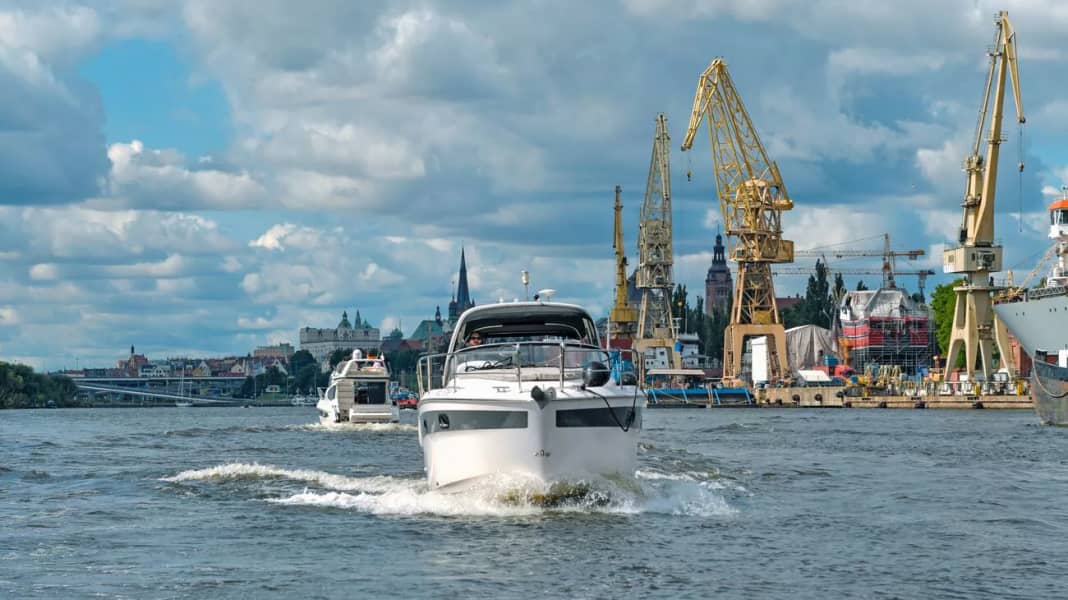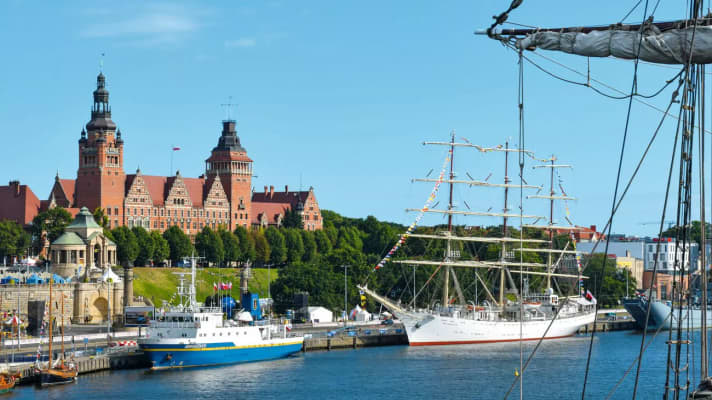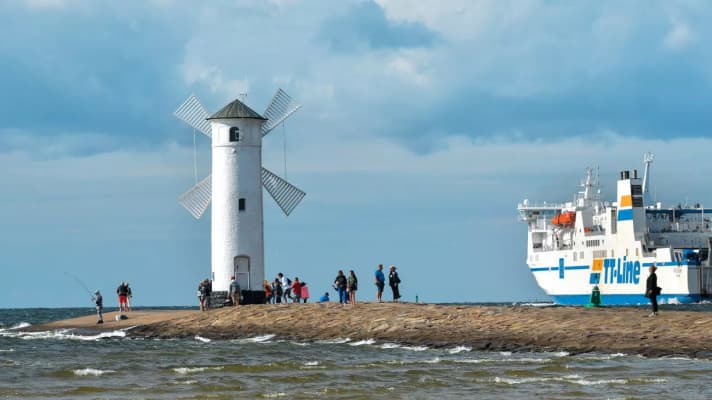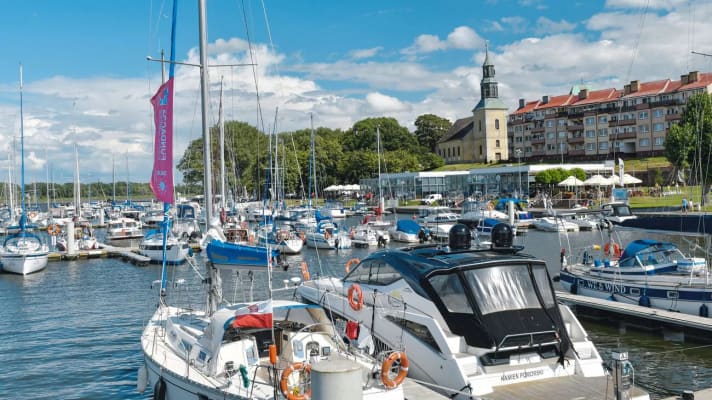
Water as far as the eye can see. Small, idyllic marinas, dreamy little towns and unspoilt nature - at first glance, the only difference between the Polish and German parts of the Szczecin Lagoon is their size. On closer inspection, things look different. "It's the famous little things," says Kapitan Jagniątkowski, "that add up to make the big difference." According to the qualified shipbuilder and head of the Polish Sailing Route Marina Association, "it starts with the mentality of the people, continues with the wind and weather - and ends in the kitchen".
We have chartered a Bavaria Sport 29, take over the fast and compact cabin cruiser in the NorthEast Marina in Szczecin and cast off around midday. A few strokes later, the Oder gurgles under the keel. To starboard, the deckchairs and parasols of the Grodzka river island come into view, while to port, the 500-metre-long Hakenterrasse with its open-air cafés, water features and neo-Renaissance palaces does the honours. A few ship lengths away, shipyards, container terminals and warehouses line up seamlessly. "How about a taste of the lagoon?" asks Theo at the wheel. The question is rhetorical. Without waiting for an answer, he leaves the city of 400,000 inhabitants in the stern and sets course for Jezioro Dąbie (Lake Dąbie) via Przekop Mieleński.

Travelling by water? Or pulling the lever? Admittedly, on the 56 square kilometre lake, the V8 of our boat could show us where the (propulsion) hammer hangs. But is that what we want? Especially as there are plenty of gillnets and fish traps. So we leave it at two or three brisk fun turns, then slow down to 1500 kilometres and enjoy the waters framed by dense forests and tall reeds. After three quarters of an hour, a strange structure rises out of the lake. As we get closer, it resembles the hull of a ship. And it is one. But not one made of steel, wood or GRP. It is - get this - made of concrete. Of course, the 90 metre long and 15 metre wide unique structure did not somehow fall from the sky. On the contrary. It's a relic from the calamity of the Second World War. Back then, IG Farben produced around 15 per cent of Germany's entire synthetic fuel requirements in nearby Pölnitz, including for the V2 rockets from Peenemünde. The fuel was transported by tankers. However, as iron and steel were too valuable, the hulls of cargo ships were often made of concrete. This was also the case with the "Ulrich Finsterwalder" in front of us. We do a lap of honour around the wreck and take the Oder back under the keel via the northern outflow of the lake, the Kanał Iński Nurt.
Police lies astern. We leave the main fairway, set course for Stepnica and moor in the Kapitan-Hilgendorf marina. After some nice small talk with the skipper of a daysailer, we make our way to the centre. There's nothing particularly earth-shattering to discover in this small town of 500 souls. The small village church is interesting. As is the information board about the man who gave his name to the marina, which opened in 2015. Robert Hilgendorf, I read, was born here in 1851, was a captain on a great voyage at a young age, was in command of what was once the world's largest five-masted barque and sailed around Cape Horn a total of 66 (!) times. The main attraction of Stepnica, however - at least for our needs - is the menu of the Tawerna Panorama. Just a few metres from the jetty, the kitchen serves solid Polish home cooking. We order baked cod with fried potatoes and spinach. It is accompanied by local craft beer and, as a tribute to the fantastic sunset, a quadruple-distilled, wonderfully smooth vodka.
The harbour basin comes alive with the first morning light. Two fishermen heave gillnets into the boat, add long poles, start the outboard motor and chug towards the lagoon. Soon afterwards, the saloon of our Bavaria fills with the aroma of freshly brewed coffee. We have breakfast and cast off. After a quarter of an hour, the village of Trzebież, Poland's largest sailing school centre, greets us, and a little later the Szczecin Lagoon rushes under the hull. "Looks interesting," Theo points to a handful of sandy islands that are as narrow as they are long. As they get closer, they turn out to be the dumping of the fairway spoil. Rumour has it that a luxury resort for the world's rich and famous could one day be built on this maritime spoil. Off the port side, a dozen or so kids are earning their first mast and sheet breakage spurs. "Cute," comments Theo to the three-cheese highs in their optimists, "that's how I started out."

Six nautical miles further on, the Brama Torowa 2 beacon is reached. Theo sets a course of 260°, crosses the invisible border to Germany and enters the town harbour of Ueckermünde after a total of 28 nautical miles. The cutter "Sir Henry" is moored just a few steps away from the tourist information centre. This fine vessel was launched in 1955 in the GDR, is 12 metres long and is now a well-known fish restaurant far beyond the town. We have a round of matjes rolls. We savour the delicacies, take a look at the pretty Wilhelminian-style houses around the nearby market square and then make our way to the former VEB ship lantern factory. In addition to the office building, there are still a few halls to be seen of Honecker's much-cited socialisation of the means of production. The office building is now a small guesthouse, one of the halls is a "museum of local history" where you can marvel at the colourful assortment of everyday utensils from the plastic-and-elastics era. We continue on to Altwarp.
"We Haff fishermen were not doing badly in the GDR," says Manfred Goldmann. What the state processing centres didn't buy, we were able to sell privately. The three-colour fish in particular brought in good money." I ask him what the three-coloured fish is. "Eel, of course," smiles the 67-year-old, "caught green, smoked brown and sold black." At the end of 1989, the Eastern Bloc was consigned to the history books. A short time later, Altwarp discovered the butter run. Up to 5,000 bargain hunters chugged their way to the neighbouring Polish village of Nowe Warpno (German: Neuwarp) every day and stocked up on duty-free smoked and drinking goods during the crossing. Poland joined the EU on 1 May 2004. That was the end of the fun. Altwarp had to - or, from the point of view of the town's purse, had to retire its customs houses ...
We say goodbye to Manfred Goldmann, who is about to take the historic shrimp cutter "Lütt Matten" out onto the lagoon for a spot of shore fishing, dock briefly in Nowe Warpno, stroll through the beautifully restored half-timbered village and then set course for Świnoujście (Swinemünde). 20 minutes later, we reach the Brama Torowa 1 beacon and the entrance to the Kanał Piastowski. 200 years ago, if you wanted to travel by ship from the Szczecin Lagoon to the Baltic Sea, you had the choice between plague and cholera: in the west, the Swedes controlled the journey through the Peene River and collected dizzyingly high tolls.

The Świna south-east of Świnoujście was (and still is!) a hullabaloo of shallows and mini-islands. Those who were unlucky ran (and still run) aground there. The third in the group, the course of the Dziwna, was already considered an unpredictable candidate for silting up in the Middle Ages. This was all too much for the Prussian King Wilhelm I. In 1875, he therefore ordered the construction of the Kaiserfahrt (now the Kanał Piastowski). Five years later, the fast steamer connection between the lagoon and the harbour of Swinemünde was put into service. At that time, today's city of 40,000 inhabitants had long since made the transition from an urban nobody to an elegant seaside resort. With large parks and splendid hotels, where aristocrats, moneyed aristocrats and artists came and went.
"Free berths," says the harbour master of the Świnoujście marina in response to my radio enquiry, "can be found in front of my office." Theo lets the Baltic ferry M/F "Polonia" pass and heads for the 300-berth marina. After a thorough inspection of the city with its seaports, extensive hotel complexes and fine sandy premium beaches, we turn to the darkest page of the city's history at Fort Gerhard. A shell's throw away from the casemates and cannons of the Prussian fortress, Latarnia Morska Świnoujście makes a much more peaceful statement. The tongue twister was put into service in 1859 and is 64.8 metres high, making it the tallest lighthouse in Poland. There are 307 steps to the top. The strenuous climb is rewarded with a fantastic view over the "fourth" - as the town likes to call itself for advertising purposes - of the Usedom imperial resorts of Ahlbeck, Heringsdorf and Bansin (just a few kilometres away).
No experiments at all! Instead of heading directly to the island of Wolin in the east of the Szczecin Lagoon via the Świna, Theo decides to take the diversions via the Kaiserfahrt. Although the Bavaria "only" has a draught of 85 centimetres, this is not a free pass for the shallow waters of the Świna. "What," Theo oracles after passing the Brama Torowa 1 beacon, "did Captain Jagniątkowski say about the capricious weather in the Szczecin Lagoon?" A glance upwards makes it clear what he is talking about. As if out of nowhere, the sky is pitch black, the wind is whipping up the Beaufort scale and St Peter is already opening his floodgates. It becomes more than uncomfortable. The waves are short and steep, the fairway is narrow and it's hard to make out the sounding in the rocking. In short, the planned detour to the cliffs off Lubin, which are up to 80 metres high, falls through in the truest sense of the word. "Here's to a vodka," breathes Theo as we reach the island's land cover half an hour later.

According to legend, a mighty city once existed on Wolin. It was called Vineta and is said to have been something like the Sodom and Gomorrah of the Baltic Sea. A divine curse washed the immoral sinner into the sea. Whether Vineta stood on the site of today's small town of Wolin, as legend has it, is pure speculation. We leave the island's namesake and her pretty brick church behind and stroll up the picturesque Dziwnów heading NE. After an hour along unspoilt nature, the café at the beautiful Kamień Pomorski marina serves the best homemade fruit ice cream. "Great," says Theo, "it's great here." I nod and reach for the guidebook. The author writes that the small town of 8,600 inhabitants is quiet and tranquil. And the absolute antithesis to the bustling tourist centre of Dziwnówek up at the mouth of the Dziwna. "Then we'll stay until tomorrow," Theo decides.
No, the Baltic Sea is not a lamb-friendly Sunday water. Especially in winter, storm surges repeatedly cause major devastation. Protecting the harbour is therefore a top priority. After forty exhilarating nautical miles on autopilot along endless sandy beaches, bustling seaside resorts and dense pine forests, we reach the town of Kołobrzeg, formerly known as Kolberg, in the afternoon. The wind and weather have long since turned their backs, meaning that the sea is smooth and the massive piers jutting out into the sea are nothing more than a playground for seagulls, cormorants and curious tourists. We whip out our smartphones and take photos of ourselves (and our Bavaria) for our holiday memories.
Fifteen minutes later, we are moored in the marina of the historic Hanseatic city. The formalities are quickly completed. Harbour master Józef has a tip: "You can eat well at the Domek Kata restaurant." After a walk through the old town, we follow his recommendation. Is it rumoured that the premises were once a courtroom and the executioner carried out the sentence right next door? Who knows. We savour roast wild boar in wild mushroom sauce with beech wheat grits - and then toast the last day of sailing with a last vodka.
You will find the travel report "From the Oder to the Baltic Sea" with service section in BOOTE issue 08/2022 from 13 July 2022 at newsstands, online directly in the Delius Klasing Shop - and already here.

